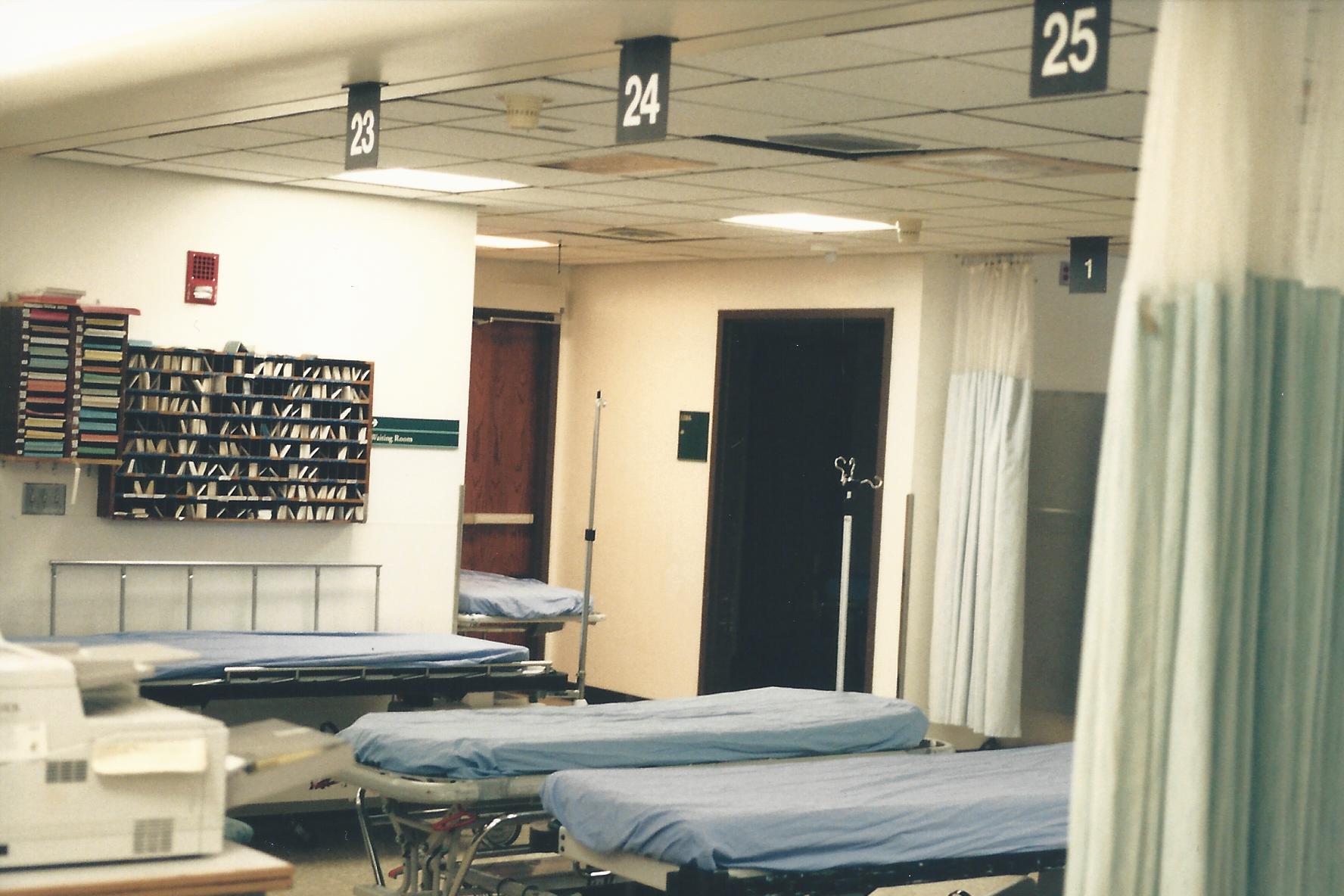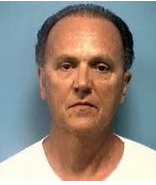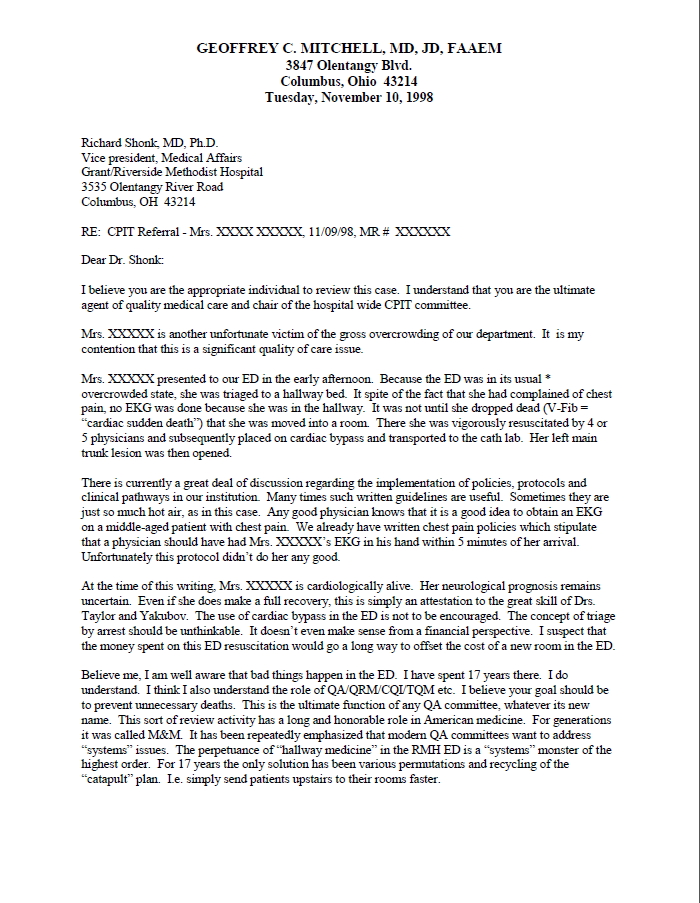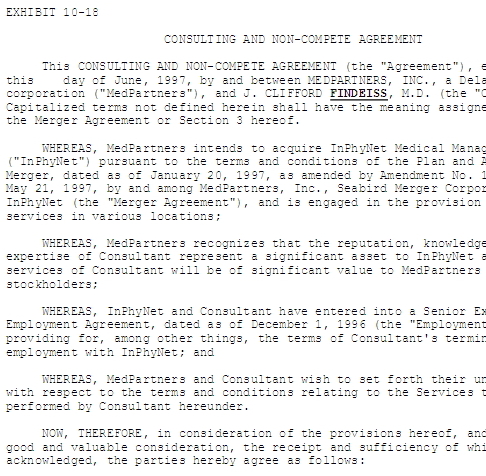The Whistleblowing
"Nobody does the right thing."
Marie Kreutz, the Bourne Identity
"Nobody does the right thing."
"Nobody does the right thing."
Marie Kreutz, the Bourne Identity
Marie Kreutz, the Bourne Identity
| I did the right thing! As a whistleblower, I presciently warned of fraudulent contracting by the notorious Richard Scrushy and his company, MedPartners. I stood against life-threatening gender discrimination in emergency care. For doing those "right things," I was severely punished. I was fired by the emergency department contract management group (the MedPartners subsidiary). The hospital always denied that it had fired me. My adversaries attacked my reputation, they presented false, lawyer-rendered psychiatric diagnoses before the Ohio Supreme Court and they pursued and won a SLAPP suit adjudicated by Judge Horton. A SLAPP suit is a "strategic lawsuit against public participation." It is a lawsuit filed strategically by a corporation against a group or activist opposing certain action taken by the corporation. |
|||||||||||||||||||
 |
Hallway Medicine
For a couple of years prior to 1998, I protested the practice of "hallway medicine" at my hospital. When a hospital hangs numbers from the ceiling, it means that they intend to treat patients in public. This is not the standard of care in America. This all came to a head in the fall of 1998. Under "hallway medicine" men got their shirts removed and had EKGs performed. Women did not! One woman had the worst sort of heart attack, an anterior myocardial infarction (MI), and was ignored in the hallway for about an hour. She then suffered a cardiac arrest and came as close to dying as is humanly possible. She was not my patient but I happened to be in the emergency department and witnessed most of the event. I wrote a letter of concern to the hospital's director of quality assurance, Dr. Shonk. For that I was fired. |
||||||||||||||||||
 |
The Scrushy Warning Memo
It is indisputable that, on March 19, 1998, I wrote and circulated what would later become known as the Scrushy Warning Memo. That memo was addressed to the hospital medical staff and it warned that Richard Scrushy's MedPartners had just lost nearly a billion dollars. I thought it would be ill-advised for the hospital to enter into a relationship with them. My memo cited Scrushy by name seven times. Little did I know that Scrushy had already paid the hospital's negotiating agent more than a million dollars to acquire the RMH ED contract. Here is a copy of the exact memo, without highlighting, as it was written and circulated in 1998. After my 1998 warning, Scrushy would go on to be found to be the most notorious fraudster in health care. He was indicted and later acquitted on eighty-five federal felony counts. His Securities and Exchange Commission sanction included an $81 million fine. He was found civilly liable for the $2.8 billion Health South fraud and he served five years in federal prison for bribing the governor of Alabama. |
||||||||||||||||||
 |
The Shonk Letter
Hallway medicine came to a head in the fall of 1998. Under "hallway medicine" men got their shirts removed in public and had EKGs performed within the requisite five minutes. Women, for obvious reasons, did not. One woman had the worst sort of anterior myocardial infarction (MI) and was ignored in the hallway for about an hour. She then suffered a cardiac arrest and came as close to dying as is humanly possible. She was not my patient but I happened to have entered the emergency department and witnessed most of the event. She was rescussitated by placing her on cardiac bypass in the middle of the emergency department. I wrote a letter of concern to the hospitals director of quality assurance, Dr. Shonk. For that I was fired. |
||||||||||||||||||
| 1st FCCCP verdict | The Wrongful Termination Suit
I filed a wrongful termination suit claiming that I was ostensibly fired for demanding equal care for women (which is an illegal violation of public policy). I was really fired because I got too close to understanding the fraudulent acquisition of the emergency department contract by MedPartners and its subsidiary. Defendants did claim that I was in fact fired for writing the Scrushy Warning Memo. The hospital and the contract group prevailed by alleging that I violated patient confidentiality. I maintain that I NEVER violated patient confidentiality. This allegation was based upon a single answer to a trick question. The truth is that Dr. Lilly was a member of the hospital’s board of trustees. He was effectively my boss. He had advised me to utilize the quality assurance process. I advised him that I had followed his recommendation. As a board member, Dr. Lilly oversaw the entire hospital quality assurance process including Dr. Shank, not just the emergency department. So, I maintain that I NEVER violated patient confidentiality. The Ohio Supeme Court seemed to appreciate this fact when, eight years after the lower court’s decision they still referred to my alleged breach of patient confidentiality as “purported.” (CITE). |
||||||||||||||||||
 |
The Scrushy-Findeiss Contract
Toward the end of my wrongful termination suit I found the Scrushy-Findeiss contract The original House-Findeiss contract as it appeared in the MedPartners SEC filing. |
||||||||||||||||||
 |
Report Published on its Website and Filed in the Congressional Record by the House Ways & Means Committee
My report concerning Richard Scrushy's fraud at Ohio hospitals was published on its website and filed in the Congressional Record by the House Ways & Means Committee. |
||||||||||||||||||
| The Rule 60(B) Motion to Vacate and the SLAPP Suit
After finding the Scrushy-Findeiss contract, I filed the 60(B) Motion to Vacate. Open link in a new window or tab: Click here to view the Rule 60B Motion to Vacate. |
|||||||||||||||||||
 |
The SLAPP Suit - Defendant's Motion for Sanctions
Defendants sued me for sanctions. They filed two separate complaints which were merged into one action. SLAPP suits are used to silence and harass critics by forcing them to spend money to defend these baseless suits. SLAPP filers don't go to court to seek justice. Rather, SLAPPS are intended to intimidate those who disagree with them or their activities by draining the target's financial resources. Source – The Public Participation Project, www.anti-slapp.org/slappdash-faqs-about-slapps, last visited 11/14/16. SLAPP suits are “often brought by businesses, government bodies, or elected officials against those who oppose them on issues of public concern.” SLAPP suits are filed against a variety of individuals and organizations who attempt to make their voice heard on an issue by expressing their First Amendment rights, to freedom of speech and freedom to petition the government. A large, well-funded organization may be SLAPPed, but more often, individuals with fewer resources are the victims of SLAPP suits. Source - ACLU of Ohio, www.acluohio.org/slapped/what-is-a-slapp-suit, last visited 11/14/16. To see one of the SLAPP suits, one defendant's Motion for Sanctions, click here. |
||||||||||||||||||
 |
". . . they will deliver you before the courts . . ." Mark 13.9 Joseph Stalin was notorious for using false psychiatric diagnoses to silence his adversaries. Here in Ohio, in pursuit of their SLAPP suit, attorneys borrowed Stalin's tactic. Absent any shred of medical evidence, Ohio attorneys rendered false psychiatric diagnoses and attested to them "Before the Supreme Court of Ohio." Any lawyer should know that lawyers are not permitted to render psychiatric diagnoses. It is indisputable fact that the challenge to my bar admission was brought under Gov.Bar R. I(11)(D)(3)(e) (mental or psychological disorder) as a direct and proximate result of a lawyer's false, lawyer-rendered psychiatric diagnosis. With the same lack of evidence and relying only upon the false, attorney-rendered psychiatric diagnosis, a different attorney then attested "Before the Supreme Court of Ohio" that I was not fit to be admitted to the bar under Gov.Bar R. I(11)(D)(3)(e) (mental illness). (See the entire attestation before the Supreme Court here.) The Ohio Supreme Court found the attorney attestation and the attorney-rendered psychiatric diagnosis to be false. They were stricken from the record and appear nowhere in the Court's decision. The attorney who rendered the false psychiatric diagnosis later denied that he ever made it. Judge Horton relied at the same time on the bar admission hearing which was initially triggered by the false, lawyer-rendered psychiatric diagnosis and at the same time the Judge relied upon the attorney's false denial that he had rendered the psychiatric diagnosis in the first place. See Motion for Sanctions. The lawyers who rendered and attested to the false psychiatric diagnoses were never disciplined. In the end, the Ohio Supreme Court held that it had "questions" about my calling attorneys liars but otherwise the Court found my "credentials and conduct are without reproach." The Supreme Court allowed me to take the bar exam and become a lawyer. I'm proud of my conduct preceding and during the bar admission hearing. My entire bar admission record was unsealed at my request. Because I was so viscously attacked by prominent law firms, the Court may have thought it had to do something. In true Soviet style, the Court sent me for reeducation, requiring that I take an ethics class. Whatever "questions" the Supreme Court had in 2008 were resoundingly answered by Ohio's leading ethicists over the next two years as the ethics experts made precisely the same allegations about the same lawyers as I had. The reader can make his or her own determination as to whether lawyers should be permitted to render psychiatric diagnoses. Go here to read more about the litigation of the SLAPP suit. |